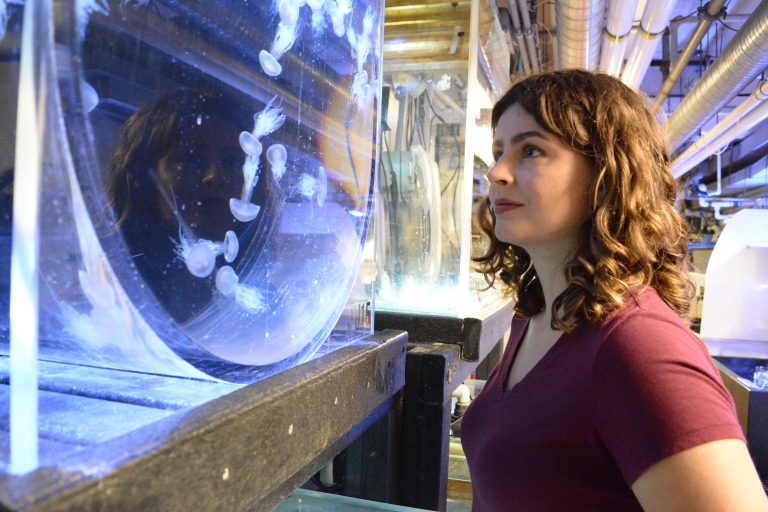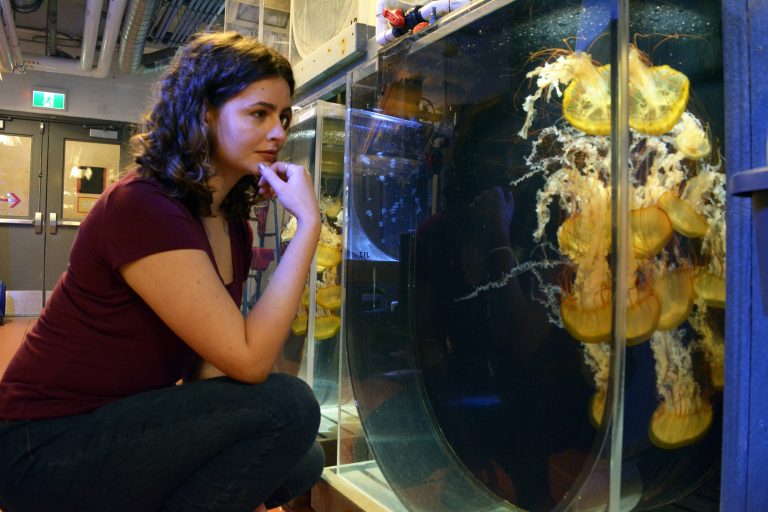
Jessica Schaub. Photo © Vancouver Aquarium
A doctoral student in the Institute for the Oceans and Fisheries and the department of earth, ocean and atmospheric sciences, Schaub will explore jellyfish blooms, huge groups of the floating ‘medusae’ in Japan, France, Argentina, and Australia, thanks to a Hugh Morris Fellowship. An Indigenous scientist, Schaub hopes her trip will inspire Indigenous youth to consider careers in science.
What’s a ‘medusa’?
Jellyfish actually have two forms. One is the floating, pulsating creature that everyone knows, called a medusa. The other is a tiny polyp that lives attached to the ground. Medusae and polyps have the same DNA, so they’re effectively clones. Large groups of medusae are known as blooms, which occur seasonally along the world’s coastlines. These blooms can cause economic and ecological hardships, including when fishers catch jellyfish instead of fish. Interestingly, polyps determine the success of blooms, such as their size, but research into these tiny creatures is scarce.
During my journey, I will travel to France and Argentina, to learn about polyp research from some of the few existing specialists, while also experiencing some of the impacts of blooms in Japan and Australia. My travels are funded by a Hugh Morris Fellowship, administered by the Kimberley Foundation, which allows Canadian graduate students researching a priority area related to earth sciences to “undertake a program of self-guided travel and experiential learning.”
What are you doing with mucus, tourists, and venomous jellyfish in Australia?

Jessica Schaub. Photo © Vancouver Aquarium
To protect tourists, researchers from the Government of Western Australia and Griffith University’s Sea Jellies Research Lab are working together to develop a type of rapid test using environmental DNA (eDNA) to sample the water prior to sending tourists out for swims. This rapid test would determine if Irukandji jellyfish are present based on the mucus they release into the water that could be detected via DNA. The higher the level of mucus, the more Irukandji are in the water, and the more dangerous it is for tourists to swim.
What do you hope the trip will mean to Indigenous youth?
Indigenous people are underrepresented in science, technology, engineering and math (STEM)-related fields due to many barriers, both historical and contemporary. For example, Indigenous methodologies are often disregarded as rigorous science, despite offering alternative and often complementary approaches to tackle joint issues. These Indigenous perspectives, like many other perspectives, are very important in STEM since they offer new ways to approach problems.
I think representation is one of the key ways that we can shift the narrative and encourage Indigenous youth to pursue STEM careers, so I try to be open and honest about the positive and negative aspects of my journey as a scientist. I hope that by sharing my story, young people can relate and see themselves as scientists too. This journey will allow me to highlight many of the things I like about science – learning, collaboration, travel, and new experiences – and I hope this will be appealing to those considering a career in STEM.
Related stories:
- Jellyfish researcher Jessica Schaub to take “international tour” thanks to Hugh Morris Fellowship, March 23, 2022
- Shedding light on mysterious jellyfish diets, October 14 2021
- HCI Marine Food Webs – Summer sampling trip to Quadra Island, September 19, 2019
- UBC researchers use drones to track jellyfish blooms, February 5, 2018
Tags: Aboriginal fisheries, awards, Indigenous fisheries, Indigenous Knowledge, IOF students, jellyfish